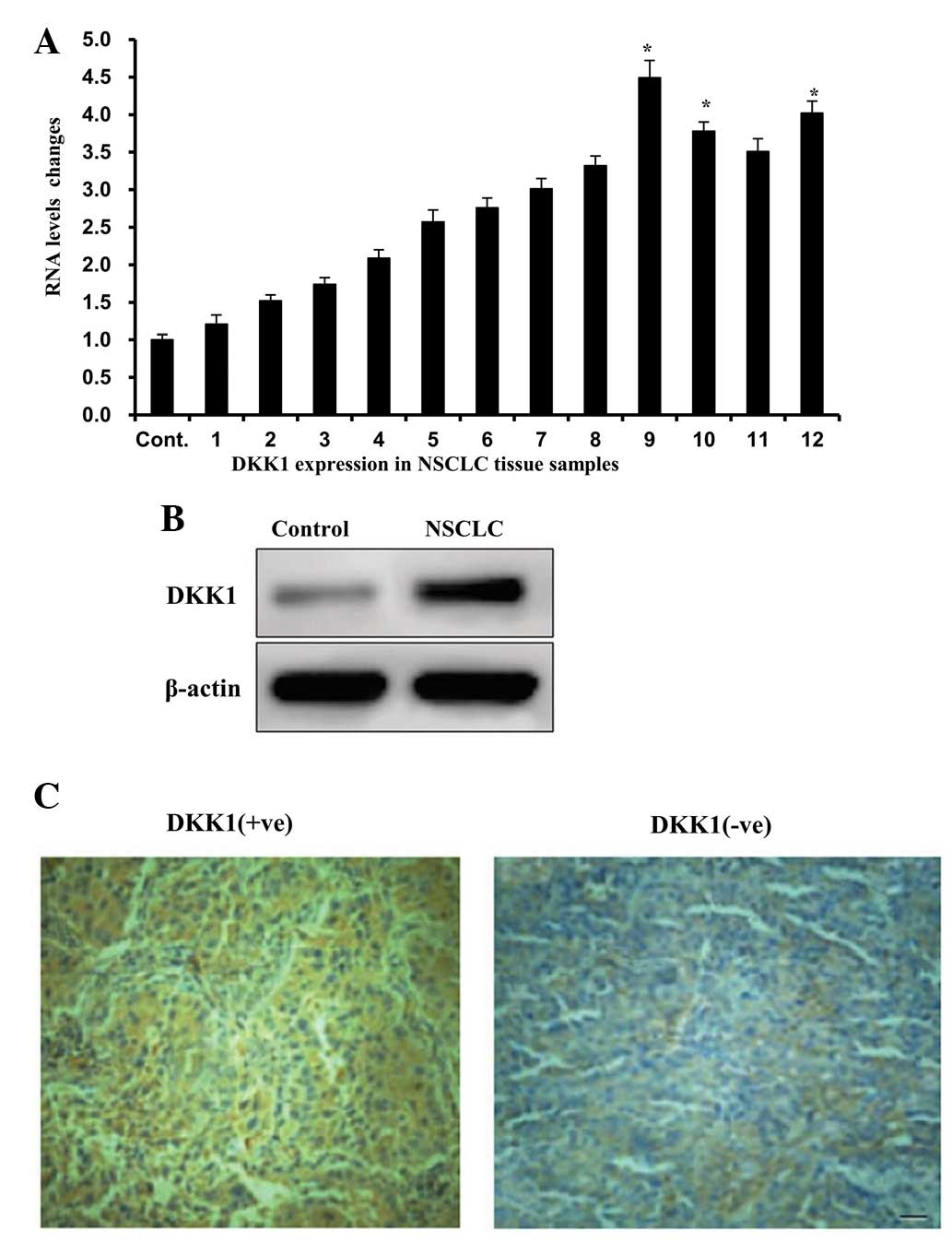|
1
|
Niida A, Hiroko T, Kasai M, et al: DKK1, a
negative regulator of Wnt signaling, is a target of the
beta-catenin/TCF pathway. Oncogene. 23:8520–8526. 2004. View Article : Google Scholar : PubMed/NCBI
|
|
2
|
Gavriatopoulou M, Dimopoulos MA,
Christoulas D, et al: Dickkopf-1: a suitable target for the
management of myeloma bone disease. Expert Opin Ther Targets.
13:839–848. 2009. View Article : Google Scholar : PubMed/NCBI
|
|
3
|
Forget MA, Turcotte S, Beauseigle D, et
al: The Wnt pathway regulator DKK1 is preferentially expressed in
hormone-resistant breast tumours and in some common cancer types.
Br J Cancer. 96:646–653. 2007. View Article : Google Scholar : PubMed/NCBI
|
|
4
|
Darlavoix T, Seelentag W, Yan P, Bachmann
A and Bosman FT: Altered expression of CD44 and DKK1 in the
progression of Barrett’s esophagus to esophageal adenocarcinoma.
Virchows Arch. 454:629–637. 2009. View Article : Google Scholar : PubMed/NCBI
|
|
5
|
Makino T, Yamasaki M, Takemasa I, et al:
Dickkopf-1 expression as a marker for predicting clinical outcome
in esophageal squamous cell carcinoma. Ann Surg Oncol.
16:2058–2064. 2009. View Article : Google Scholar : PubMed/NCBI
|
|
6
|
Wirths O, Waha A, Weggen S, Schirmacher P,
Kühne T, et al: Overexpression of human Dickkopf-1, an antagonist
of wingless/WNT signaling, in human hepatoblastomas and Wilms’
tumors. Lab Invest. 83:429–434. 2003. View Article : Google Scholar : PubMed/NCBI
|
|
7
|
Marvin MJ, Di Rocco G, Gardiner A, et al:
Inhibition of Wnt activity induces heart formation from posterior
mesoderm. Genes Dev. 15:316–327. 2001. View Article : Google Scholar : PubMed/NCBI
|
|
8
|
Mountain CF: Revisions in the
international system for staging lung cancer. Chest. 111:1710–1717.
1997. View Article : Google Scholar : PubMed/NCBI
|
|
9
|
Martini N, Bains MS, Burt ME, et al:
Incidence of local recurrence and second primary tumors in resected
stage I lung cancer. J Thorac Cardiovasc Surg. 109:120–129. 1995.
View Article : Google Scholar : PubMed/NCBI
|
|
10
|
Chen WQ, Zheng RS and Zeng HM: Bayesian
age-period-cohort prediction of lung cancer incidence in China.
Thoracic Cancer. 2:149–155. 2011. View Article : Google Scholar
|
|
11
|
Chen W, Zheng R, Zhang S, Zou X, Zhao P,
et al: Lung cancer incidence and mortality in China, 2009. Thoracic
Cancer. 4:102–108. 2013. View Article : Google Scholar
|
|
12
|
Zeng H, Zheng R, Zhang S, He J and Chen W:
Lung cancer incidence and mortality in China, 2008. Thoracic
Cancer. 4:53–58. 2013. View Article : Google Scholar
|
|
13
|
Fukuyama Y, Mitsudomi T, Sugio K, et al:
K-ras and p53 mutations are an independent unfavourable prognostic
indicator in patients with non-small-cell lung cancer. Br J Cancer.
75:1125–1130. 1997. View Article : Google Scholar : PubMed/NCBI
|
|
14
|
Osaki T, Mitsudomi T, Oyama T, Nakanishi R
and Yasumoto K: Serum level and tissue expression of c-erbB-2
protein in lung adenocarcinoma. Chest. 108:157–162. 1995.
View Article : Google Scholar : PubMed/NCBI
|
|
15
|
Oyama T, Osaki T, Mitsudomi T, et al: p53
alteration, proliferating cell nuclear antigen and nucleolar
organizer regions in thymic epithelial tumors. Int J Mol Med.
1:823–826. 1998.PubMed/NCBI
|
|
16
|
Bradford MM: A rapid and sensitive method
for the quantitation of microgram quantities of protein utilizing
the principle of protein-dye binding. Anal Biochem. 72:248–254.
1976. View Article : Google Scholar : PubMed/NCBI
|
|
17
|
Tammemägi MC, Katki HA, Hocking WG, et al:
Selection criteria for lung-cancer screening. New Engl J Med.
368:728–736. 2013. View Article : Google Scholar : PubMed/NCBI
|
|
18
|
Takahashi N, Fukushima T, Yorita K, Tanaka
H, Chijiiwa K, et al: Dickkopf-1 is overexpressed in human
pancreatic ductal adenocarcinoma cells and is involved in invasive
growth. Int J Cancer. 126:1611–1620. 2010.
|
|
19
|
Yamabuki T, Takano A, Hayama S, Ishikawa
N, Kato T, et al: Dikkopf-1 as a novel serologic and prognostic
biomarker for lung and esophageal carcinomas. Cancer Res.
67:2517–2525. 2007. View Article : Google Scholar : PubMed/NCBI
|
|
20
|
González-Sancho JM, Aguilera O, García JM,
et al: The Wnt antagonist DICKKOPF-1 gene is a downstream target of
beta-catenin/TCF and is downregulated in human colon cancer.
Oncogene. 24:1098–1103. 2005. View Article : Google Scholar
|
|
21
|
Yu B, Yang X, Xu Y, Yao G, Shu H, et al:
Elevated expression of DKK1 is associated with cytoplasmic/nuclear
beta-catenin accumulation and poor prognosis in hepatocellular
carcinomas. J Hepatol. 50:948–957. 2009. View Article : Google Scholar : PubMed/NCBI
|
|
22
|
Sheng SL, Huang G, Yu B and Qin WX:
Clinical significance and prognostic value of serum Dickkopf-1
concentrations in patients with lung cancer. Clin Chem.
55:1656–1664. 2009. View Article : Google Scholar : PubMed/NCBI
|
|
23
|
Qin X, Zhang H, Zhou X, Wang C, Zhang X,
et al: Proliferation and migration mediated by
Dkk-1/Wnt/beta-catenin cascade in a model of hepatocellular
carcinoma cells. Transl Res. 150:281–294. 2007. View Article : Google Scholar : PubMed/NCBI
|
|
24
|
Yao X, Jiang H, Zhang C, Wang H, Yang L,
et al: Dickkopf-1 autoantibody is a novel serological biomarker for
non-small cell lung cancer. Biomarkers. 15:128–134. 2010.
View Article : Google Scholar
|
|
25
|
Osada H, Tomida S, Yatabe Y, Tatematsu Y,
Takeuchi T, et al: Roles of achaetescute homologue 1 in DKK1 and
E-cadherin repression and neuroendocrine differentiation in lung
cancer. Cancer Res. 68:1647–1655. 2008. View Article : Google Scholar : PubMed/NCBI
|
|
26
|
Licchesi JD, Westra WH, Hooker CM, Machida
EO, Baylin SB, et al: Epigenetic alteration of Wnt pathway
antagonists in progressive glandular neoplasia of the lung.
Carcinogenesis. 29:895–904. 2008. View Article : Google Scholar : PubMed/NCBI
|













